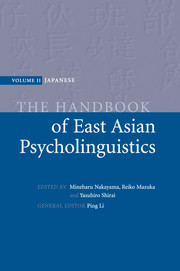Book contents
- Frontmatter
- Contents
- List of figures
- List of contributors
- In memory of Miwa Nishimura
- Preface
- Introduction
- Language acquisition
- Part II Language processing
- 26 The phonetic and phonological organization of speech in Japanese
- 27 Speech segmentation by Japanese listeners: its language-specificity and language-universality
- 28 Prosody in sentence processing
- 29 Speech errors
- 30 Effects of word properties on Japanese sentence processing
- 31 Orthographic processing
- 32 Lexical access
- 33 Incrementality in Japanese sentence processing
- 34 Processing alternative word orders in Japanese
- 35 Processing relative clauses in Japanese: coping with multiple ambiguities
- 36 Processing empty categories in Japanese
- 37 The difficulty of certain sentence constructions in comprehension
- 38 Reading and working memory
- 39 Sentence production in Japanese
- 40 The neural basis of syntactic processing in Japanese
- 41 The competition model
- 42 Connectionist models
- 43 Computational linguistics
- 44 Language and gesture as a single communicative system
- References
- Name index
- Subject index
38 - Reading and working memory
from Part II - Language processing
Published online by Cambridge University Press: 05 June 2012
- Frontmatter
- Contents
- List of figures
- List of contributors
- In memory of Miwa Nishimura
- Preface
- Introduction
- Language acquisition
- Part II Language processing
- 26 The phonetic and phonological organization of speech in Japanese
- 27 Speech segmentation by Japanese listeners: its language-specificity and language-universality
- 28 Prosody in sentence processing
- 29 Speech errors
- 30 Effects of word properties on Japanese sentence processing
- 31 Orthographic processing
- 32 Lexical access
- 33 Incrementality in Japanese sentence processing
- 34 Processing alternative word orders in Japanese
- 35 Processing relative clauses in Japanese: coping with multiple ambiguities
- 36 Processing empty categories in Japanese
- 37 The difficulty of certain sentence constructions in comprehension
- 38 Reading and working memory
- 39 Sentence production in Japanese
- 40 The neural basis of syntactic processing in Japanese
- 41 The competition model
- 42 Connectionist models
- 43 Computational linguistics
- 44 Language and gesture as a single communicative system
- References
- Name index
- Subject index
Summary
Working memory in reading
Working memory refers to the temporary storage of information while processing incoming data and retrieving relevant information from long-term storage. Working memory plays an important role in complex cognition such as language comprehension, learning, and reasoning (Baddeley, 1986; Just & Carpenter, 1992). In Baddeleys's model, working memory is composed of a central executive system and two subsidiary systems, that is, the phonological loop and the visuo-spatial sketchpad (Baddeley, 1986). The central executive is assumed to serve as an attention controller that allocates and coordinates attentional resources for cognitive tasks (Baddeley, 1996; Engle, Kane & Tuholski, 1999). The phonological loop is thought to store acoustic and phonological properties of words, letters, and numbers together with the subvocal rehearsal system. The visuo-spatial sketchpad is thought to support temporary memory of visual appearance and layout a scene together with movement through the scene. Recently, a new subsystem, the episodic buffer, has been added and assigned a role of retrieving data from a knowledge base of skills and information acquired during past experience (Baddeley, 2000).
Working memory plays an important role in reading. In reading, incoming information must be decoded perceptually, as it involves retrieving information about grapheme–phoneme conversion rules, word meanings and syntax; then the information must be reorganized and integrated with a contextual interpretation (Carpenter & Just, 1989; Daneman & Carpenter, 1980; Kintsch & Van Dijk, 1978).
- Type
- Chapter
- Information
- The Handbook of East Asian Psycholinguistics , pp. 285 - 290Publisher: Cambridge University PressPrint publication year: 2006



